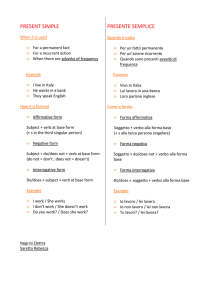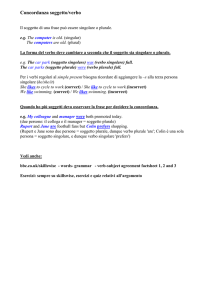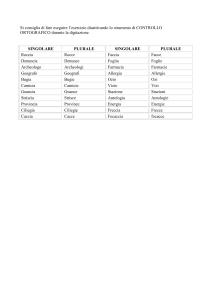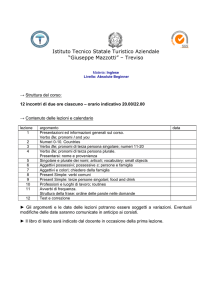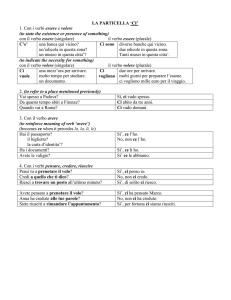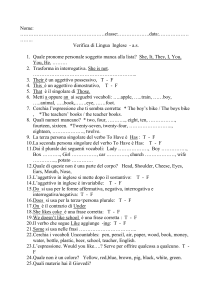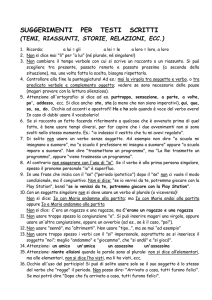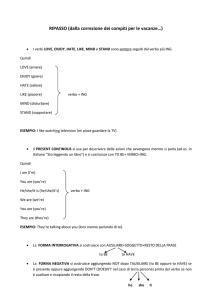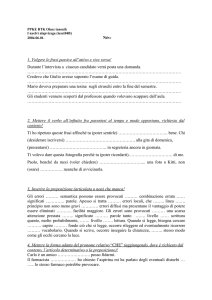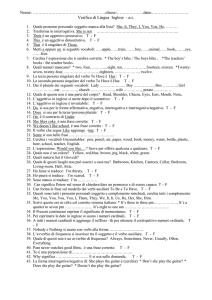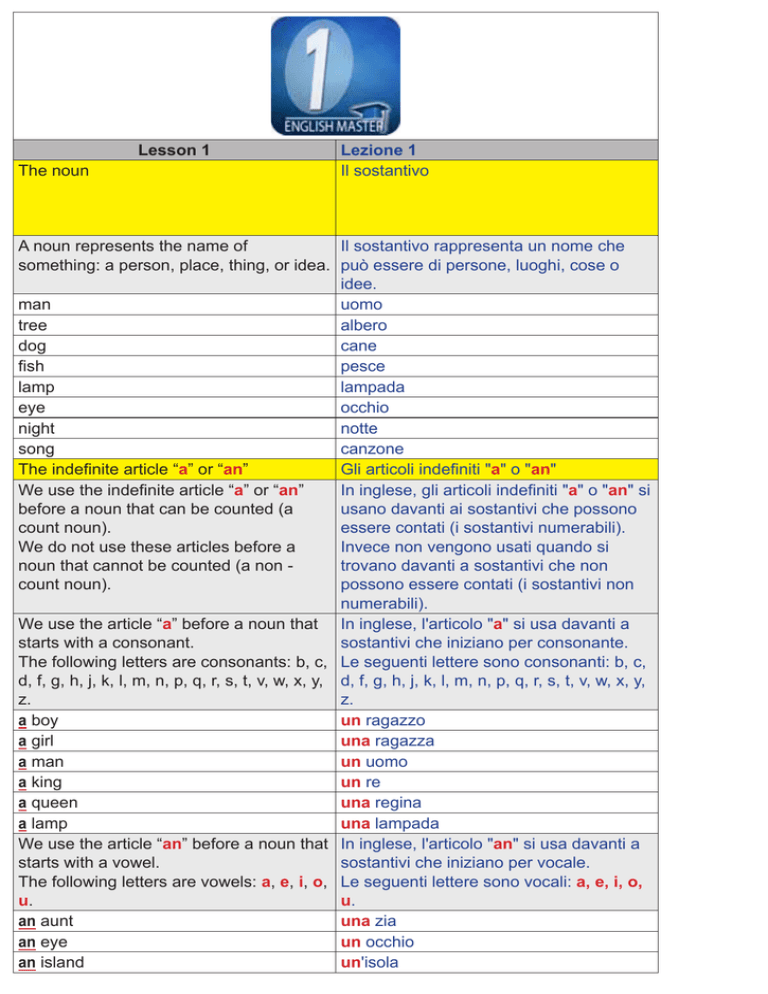
The noun
Lesson 1
Lezione 1
Il sostantivo
A noun represents the name of
Il sostantivo rappresenta un nome che
something: a person, place, thing, or idea. può essere di persone, luoghi, cose o
idee.
man
uomo
tree
albero
dog
cane
fish
pesce
lamp
lampada
eye
occhio
night
notte
song
canzone
The indefinite article “a” or “an”
Gli articoli indefiniti "a" o "an"
We use the indefinite article “a” or “an”
In inglese, gli articoli indefiniti "a" o "an" si
before a noun that can be counted (a
usano davanti ai sostantivi che possono
count noun).
essere contati (i sostantivi numerabili).
We do not use these articles before a
Invece non vengono usati quando si
noun that cannot be counted (a non trovano davanti a sostantivi che non
count noun).
possono essere contati (i sostantivi non
numerabili).
We use the article “a” before a noun that In inglese, l'articolo "a" si usa davanti a
starts with a consonant.
sostantivi che iniziano per consonante.
The following letters are consonants: b, c, Le seguenti lettere sono consonanti: b, c,
d, f, g, h, j, k, l, m, n, p, q, r, s, t, v, w, x, y, d, f, g, h, j, k, l, m, n, p, q, r, s, t, v, w, x, y,
z.
z.
a boy
un ragazzo
a girl
una ragazza
a man
un uomo
a king
un re
a queen
una regina
a lamp
una lampada
We use the article “an” before a noun that In inglese, l'articolo "an" si usa davanti a
starts with a vowel.
sostantivi che iniziano per vocale.
The following letters are vowels: a, e, i, o, Le seguenti lettere sono vocali: a, e, i, o,
u.
u.
an aunt
una zia
an eye
un occhio
an island
un'isola
an orange
an uncle
an hour
The word “hour” starts with the
consonant h, but it sounds like it starts
with a vowel (“our”), so we use the article
“an” before it.
a university
a European
In the word “European”, the vowel e
sounds like the consonant y. Likewise,
the word university sounds like it starts
with a consonant, so we use the article
“a” before these words.
un'arancia
uno zio
un'ora
La parola "hour" (=ora) inizia con la
consonante h, ma è come se iniziasse
per vocale (si pronuncia our), quindi si
usa l'articolo "an".
un'università
un europeo
Nella parola "European", la vocale e si
pronuncia come la consonante y. Allo
stesso modo, la parola "university"
si pronuncia come se iniziasse per
consonante, quindi davanti a queste
parole usiamo l'articolo "a".
Singular and Plural
Singolare e plurale
Plural form is usually achieved by adding Di solito, il plurale di un nome si forma
an s to the singular form of a noun.
aggiungendo una s finale alla forma
If the noun ends with f, k, p, t or th, then singolare.
the plural s is pronounced as /s/ (as in
Se il sostantivo finisce per f, k, p, t o th,
“books”).
il plurale con la s si pronuncia come la s
italiana (come in “books” =libri).
For the plural of nouns ending in “ch”, “s”, Per il plurale di nomi terminanti in "ch",
“sh” or “x” see Lesson 2
"s", "sh" o "x", rimandiamo alla Lezione 2
Singular
Il singolare
a book
un libro
a map
una cartina
a roof
un tetto
a month
un mese
an aunt
una zia
Plural
Il plurale
books
libri
maps
cartine
roofs
tetti
months
mesi
aunts
zie
If the noun ends with any other letter, then Se il sostantivo termina con una delle
the plural s is pronounced as in “bags”.
altre lettere, vocali o consonanti (eccetto
la vocale o e le consonanti sopra indicate
e quelle elencate nella Lezione 2), la s
finale del plurale si pronuncia come la
s sonora dell'italiano di "rosa", come in
"bags" (=borse).
Singular
Il singolare
a bag
una borsa
a girl
una ragazza
a room
una stanza
a chair
una sedia
a pen
an uncle
Plural
bags
girls
rooms
chairs
pens
uncles
If the noun ends with ch, sh, s, or x,
then we add an “es” to achieve the plural
form, instead of an s. The plural “es” is
pronounced as in “boxes”.
Singular
a bus
a box
a brush
a dress
a match
Plural
buses
boxes
brushes
dresses
matches
We also add the plural “es” to nouns that
end with o.
Singular
a tomato
Plural
tomatoes
Note: The indefinite articles “a” and “an”
are not used with nouns in plural form.
Singular (with an article)
a boy
a girl
a bus
an uncle
Plural (without an article)
boys
girls
buses
uncles
Likewise, these articles are not used with
singular, non - count nouns.
water
una penna
uno zio
Il plurale
borse
ragazze
stanze
sedie
penne
zii
Se il sostantivo termina con ch, sh, s, o
x, per formare il plurale si aggiunge "es"
alla fine, invece di s. Il plurale "es" si
pronuncia iz, come in "boxes" (=scatole).
Il singolare
un bus
una scatola
una spazzola
un abito
un fiammifero
Il plurale
bus
scatole
spazzole
abiti
fiammiferi
In inglese, il plurale si forma aggiungendo
"es" anche ai nomi che terminano per o.
Il singolare
un pomodoro
Il plurale
pomodori
Nota: gli articoli indefiniti "a" e "an" non
vengono usati con nomi plurali.
Singolare (con articolo)
Plurale (senza articolo)
Allo stesso modo, questi articoli non
vengono usati con nomi singolari non
numerabili.
acqua
sand
The definite article “the”
We use the definite article “the” before a
noun, when the noun refers to a specific
person, place, thing, or idea.
sabbia
L'articolo definito "the"
Il inglese, l'articolo definito "the" si usa
davanti ai sostantivi che si riferiscono
a una persona, un luogo, una cosa o
un'idea specifica.
the boy
il ragazzo
the girl
la ragazza
the room
la stanza
the box
la scatola
the match
il fiammifero
the boys
i ragazzi
the girls
le ragazze
the rooms
le stanze
the boxes
le scatole
the matches
i fiammiferi
Note: The article “the” can be used
Nota: L'articolo "the" si usa davanti a
before any noun, whether singular, plural, qualunque nome, sia esso singolare,
feminine, masculine, or gender - neuter.
plurale, femminile o maschile.
Masculine, singular
Maschile singolare
the boy
Feminine, singular
Femminile singolare
the girl
Masculine, plural
Maschile plurale
the boys
Feminine, plural
Femminile plurale
the girls
Object, singular
Oggetto inanimato (senza genere)
singolare
the room
Object, plural
Oggetto inanimato (senza genere) plurale
the rooms
Gender in the English language
Il genere in inglese
Regarding gender, English nouns can be: Per quanto riguarda il genere, in inglese i
1. masculine, for male beings.
sostantivi possono essere:
2. feminine, for female beings.
1. maschili, per esseri viventi di sesso
3. common, for both male and female
maschile.
(student, doctor)
2. femminili, per esseri viventi di sesso
4. neuter, mostly for inanimate objects
femminile.
3.comuni, la stessa forma per maschile e
femminile (ministro, avvocato)
4. neutri, principalmente per oggetti
inanimati
Masculine nouns
Sostantivi maschili
a king
un re
a man
un uomo
an uncle
uno zio
a boy
un ragazzo
Feminine nouns
a qeen
a woman
an aunt
a girl
Gender - common nouns
a lamp
Sostantivi femminili
una regina
una donna
una zia
una ragazza
Il genere - Sostantivi che in inglese hanno
forma uguale al maschile e al femminile
un ballerino
un cantante
un insegnante
uno studente
Il genere - Sostantivi che in inglese sono
neutri
una lampada
a pen
a map
a tree
una penna
una cartina
un albero
a dancer
a singer
a teacher
a student
Gender - neuter nouns
Lesson 2
Lezione 2
Vocabulary
Vocabolario
orange
arancia (frutto), colore arancione
coat
cappotto
ice cream
gelato (dessert)
English
inglese
bone
osso
teach
insegnare
dress (v)
indossare
dress (n)
abito
Note: The word “dress” can be used both Nota: in inglese, la parola "dress" indica
as a noun (a type of clothes) or a verb
sia il sostantivo (abito da donna) sia il
(to put on clothes).
verbo (indossare dei vestiti).
brush (v)
spazzolare
brush (n)
spazzola
shoe
scarpa
go
andare
apple
mela
coffee
caffè
juice
succo
tea
tè
wear
indossare
pants
pantaloni, mutande da uomo
shirt
sell
I
you
he
she
it
we
they
write
eat
speak
read
drink (v)
drink (n)
buy
letter
banana
book
water
cake
milk
hat
Subject pronouns
Singular
I
you
he
she
it
Plural
we
you
they
Note: The pronoun “it” is gender - neuter,
and is used for objects, animals, and
concepts. The plural of “it” is “they”.
The word “I” is always capitalized.
The verb
A verb represents an action or
condition.
write
eat
camicia
vendere
io
tu, voi
lui
lei
esso (riferito a oggetti inanimati)
noi
loro
scrivere
mangiare
parlare
leggere
bere
bibita
acquistare
lettera
banana
libro
acqua
torta
latte
cappello
Pronomi personali soggetto
Il singolare
io
tu
lui
lei
esso (riferito a oggetti inanimati)
Il plurale
noi
voi
loro
Nota: il pronome "it" è di genere neutro e
viene usato per oggetti inanimati, animali
e concetti. Il plurale di "it" è "they".
La parola "I" è sempre maiuscola.
Il verbo
Il verbo rappresenta un’azione o
una condizione. Il verbo rappresenta
un’azione o una condizione.
scrivere
mangiare
speak
read
drink
parlare
leggere
bere, bevanda
buy
In English, each sentence must include a
verb.
There are two types of verbs:
1. Pure main verbs
2. Auxiliary verbs: be, do, have (which
may also act like main verb)
In this lesson, we will look at common
main verbs only (Present Tense).
I write an email
I eat a banana
I read a book
I drink water
Note: The indefinite article “a” or “an”
is used only before a count noun. In
the sentence “I drink water,” the word
“water” is a non - count noun.
acquistare
In inglese, ogni frase deve includere il
verbo e il soggetto che compie l'azione,
mentre in italiano il soggetto può essere
sottinteso e quindi omesso.
Esistono due tipi di verbi:
1. Verbi principali
2. Verbi ausiliari: be, do, have (che
possono essere anche verbi principali)
In questa lezione, osserveremo
solamente i verbi principali più comuni
(al tempo presente).
Scrivo un' e-mail
Mangio una banana
Leggo un libro
Bevo acqua
Nota: gli articoli indefiniti "a" o "an" si
usano solamente davanti a un sostantivo
numerabile. Nella frase "I drink water", il
sostantivo "water" è non-numerabile.
Important! Usually, in English the subject Importante! Di solito, in inglese il
comes before the predicate.
soggetto viene prima del predicato e
deve sempre essere espresso (mai
sottinteso).
I eat a cake
Mangio un dolce
You drink milk
Bevi latte
He buys a hat
Lui compra un cappello
She sells oranges
Lei vende arance
We wear coats
Noi indossiamo cappotti
You speak French
Tu parli francese
They like ice-cream
Loro amano il gelato
In the third-person singular (both
Nel tempo presente, alla terza persona
masculine and feminine), in Present
singolare (maschile, femminile e neutra)
Tense, we add an s to the verb.
aggiungiamo una s finale al verbo.
Note: Each sentence starts with a capital Nota: tutte le frasi iniziano con lettera
letter.
maiuscola.
He drinks water
Lui beve acqua
She speaks English
Lei parla inglese
It eats bones
Mangia gli ossi
Note: We use the pronoun “it” instead of Nota: in inglese si usa il pronome "it"
“he” or “she”, when referring to animals.
invece di "he" o "she" per riferirsi agli
animali e non può essere sottinteso, al
contrario dell'italiano.
In the third - person singular, if a verb
ends with “ch”, “s”, or “sh”, we add
the syllable “es”. This consonant “s” is
pronounced as /s/ in “books”.
The same rule applies to the plural of
nouns ending with those consonants in
the singular.
Se un verbo termina in "ch", "s" o "sh",
alla terza persona singolare aggiungiamo
la sillaba "es". In questo caso, la
consonante "s" si pronuncia come la s
italiana, come in "books".
La stessa regola si applica ai sostantivi
plurali la cui forma singolare termini con
le consonanti sopra indicate.
He teaches English
She brushes a shoe
She dresses Emily
In the third-person singular, if a verb ends
with an o, we add an “es”.
He goes
She goes
Exercise
Let’s read out loud.
I eat a cake.
I eat an orange
I eat apples
I eat a banana
I eat ice cream
You drink water
You drink coffee
You drink juice
You drink tea
You drink milk
She buys a coat
She buys cakes
She buys a book
She buys apples
She buys a dress
He wears a hat
He wears shoes
He wears a coat
He wears pants
He wears a shirt
We sell oranges
We sell cakes
We sell books
We sell hats
We sell bananas
Lui insegna inglese
Lei spazzola una scarpa
Lei veste Emily
Se un verbo termina in "o", alla terza
persona singolare si aggiunge "es".
Lui va
Lei va
Esercizio
Leggi ad alta voce
Vocabulary
yes
no
not
to
do
supper
breakfast
lunch
dinner
egg
hospital
school
prison
synagogue
church
mosque
mall
football
basketball
handball
chess
French
German
Italian
Spanish
newspaper
magazine
Internet
blog
website
comedy
tragedy
play (n)
story
does
play (v)
beer
learn
Lesson 3
Lezione 3
Vocabolario
sì
no
non
a (preposizione)
fare
cena
colazione
pranzo
cena
uovo
ospedale
scuola
prigione
sinagoga
chiesa
moschea
centro commerciale
sport del calcio
basket
pallamano
scacchi
francese
tedesco
italiano
spagnolo
giornale quotidiano
rivista
Internet
blog
sito web
commedia
tragedia
opera teatrale
storia
fa (terza persona singolare del verbo do)
suonare, giocare
birra
imparare
rice
bake
bread
sing
song
wine
tennis
answer
question
Present Tense – negative form
We make the negative form, by adding
“do not” before the verb.
I eat breakfast
I do not eat breakfast
I go to school
I do not go to school
You speak English
You do not speak English
In the third - person singular (“he, she,
it”), we make the negative form by adding
“does not” before the verb. The “-s” or
“-es” at the end of the verb is dropped.
He plays football
He does not play football
riso (cibo)
cuocere al forno
pane
cantare
canzone
vino
tennis
rispondere, risposta
domandare, domanda
Tempo presente - Forma negativa
La negazione si forma aggiungendo "do
not" davanti al verbo.
Faccio colazione
Non faccio colazione
Vado a scuola
Non vado a scuola
Parli inglese
Non parli inglese
Alla terza persona singolare (he, she, it),
la negazione si forma aggiungendo "does
not" davanti al verbo. La "-s" o "-es" in
fondo al verbo viene omessa.
Lui gioca a calcio
Lui non gioca a calcio
She writes a story
She does not write a story
We drink beer
We do not drink beer
You learn French
You do not learn French
They read a book
They do not read a book
Present Tense – interrogative form
We make the interrogative form, by
adding “do” at the beginning of the
sentence.
I drink milk
Do I drink milk?
You eat rice
Do you eat rice?
In the third-person singular (he, she, it),
we make the interrogative form, by adding
“does” at the beginning of the sentence.
The s or es at the end of the verb are
dropped
He bakes bread
Does he bake bread?
Lei scrive una storia
Lei non scrive una storia
Noi beviamo birra
Noi non beviamo birra
Imparate francese
Non imparate francese
Loro leggono un libro
Loro non leggono un libro
Tempo presente - Forma interrogativa
La frase interrogativa si forma
aggiungendo "do" a inizio frase.
Bevo latte
Bevo latte?
Mangi riso
Mangi riso?
Alla terza persona singolare (he, she,
it), l'interrogativa si forma aggiungendo
"does" a inizio frase. La “-s” o “-es” in
fondo al verbo viene omessa
Lui cuoce il pane
Cuoce il pane?
She sings a song
Does she sing a song?
We drink wine
Do we drink wine?
You play tennis
Do you play tennis?
They answer questions
Do they answer questions?
Questions and answers
Do you drink water?
No, I do not drink water.
I drink milk.
Do you eat bananas?
No, I do not eat bananas.
I eat oranges.
Do you learn French?
No, I do not learn French.
I learn Spanish.
Do you play football?
No, I do not play football.
I play tennis.
Do you eat bread?
Yes, I eat bread.
Do you write letters?
Yes, I write letters.
Do you teach English?
Yes, I teach English.
Exercise
Let’s read out loud.
You eat breakfast
You eat supper
You eat lunch
You eat dinner
You eat eggs
He goes to school
He goes to hospital
He goes to prison
He goes to synagogue
He goes to church
We do not play football
We do not play basketball
We do not play handball
We do not play tennis
We do not play chess
She learns French
She learns German
She learns English
Lei canta una canzone
Canta una canzone?
Noi beviamo vino
Beviamo vino?
Voi giocate a tennis
Giocate a tennis?
Loro rispondono alle domande
Rispondono alle domande?
Domande e risposte
Bevi acqua?
No, non bevo acqua.
Bevo latte.
Mangi le banane?
No, non mangio le banane.
Mangio le arance.
Impari il francese?
No, non imparo il francese.
Imparo lo spagnolo.
Giochi a calcio?
No, non gioco a calcio.
Gioco a tennis.
Mangi il pane?
Sì, mangio il pane.
Scrivi delle lettere?
Sì, scrivo delle lettere
Insegni inglese?
Sì, insegno inglese.
Esercizio
Leggi ad alta voce
She learns Spanish
Do they read newspapers?
Do they read magazines?
Do they read comedies?
Do they read tragedies?
Do they read books?
Vocabulary
fruit
vegetable
animal
dancer
farmer
baker
pear
grape
peach
melon
potato
tomato
cucumber
onion
pea
lion
tiger
bear
cat
dog
am
a
boy
are
girl
is
man
woman
parents
men
women
elephant
Lesson 4
Lezione 4
Vocabolario
frutta
verdura
animale
ballerino, ballerina
agricoltore
fornaio
pera
uva
pesca
melone
patata
pomodoro
cetriolo
cipolla
pisello
leone
tigre
orso
gatto
cane
sono (verbo ausiliare to be)
un, uno, una (articolo indefinito)
ragazzo
sei, siamo, siete (verbo ausiliare to be)
ragazza
è (verbo ausiliare to be)
uomo
donna
genitori
uomini
donne
elefante
city
country
continent
mountain
river
driver
teacher
student
The verb “be”
The verb “be” is used to indicate a state.
As Hamlet said: “To be or not to be…”
Conjugation of the verb “be” in the
present tense
I am
you are
he is
she is
it is
we are
you are
they are
Note: The verb “am” follows the pronoun
“I”. The verb “are” follows the pronouns
“you”, “we”, and “they”. The verb “is”
follows the pronouns “he”, “she”, and “it”.
I am a girl
You are a man
He is a boy
She is a woman
We are parents
You are men
They are women
It is a book
It is an elephant
Note: The words “is” and “are” can also
follow nouns. For example: “New York is
a city”.
Great Britain is a country
Asia is a continent
Mount Everest is a mountain
The Amazon River is a river
Doug is a driver
città
nazione, campagna
continente
montagna
fiume
autista
insegnante
studente
Il verbo "to be"
Il verbo "To be" significa essere e si
usa in inglese anche per indicare la
professione. Come dice Amleto: "To be or
not to be..." (Essere o non essere...)
Presente indicativo del verbo "be"
Io sono
Tu sei
Lui è
Lei è
(Esso) È
Noi siamo
Voi siete
Loro sono
Nota: il verbo "am" segue il pronome "I".
Il verbo "are" segue i pronomi "you", "we"
e "they". Il verbo "is" segue i pronomi
"he", "she" e "it". Sebbene in italiano il
soggetto spesso si ometta, in inglese va
sempre indicato.
Sono una ragazza
Sei un uomo
Lui è un ragazzo
Lei è una donna
Noi siamo genitori
Voi siete uomini
Loro sono donne
È un libro
È un elefante
Nota: come in italiano, le parole "is" e
"are" possono servire da copula o unione
tra due sostantivi, e quindi essere seguiti
da un sostantivo, ad esempio: "New York
is a city" (=New York è una città).
La Gran Bretagna è una nazione
L'Asia è un continente
Il Monte Everest è una montagna
Il Rio delle Amazoni è un fiume
Doug è autista
Emily is a teacher
Dan is a student.
Oranges are fruit
Potatoes are vegetables
Lions are animals
Note: In English, we do not say, “I boy”.
Instead, we say, “I am a boy”.
Exercise
Let’s read out loud.
He is a driver
Emily è insegnante
Dan è uno studente
Le arance sono frutti
Le patate sono verdure
I leoni sono animali
Nota: in inglese, come in italiano, non si
può omettere il verbo. Ad esempio non
si dice "I boy" (=io ragazzo), ma "I am a
boy" (=io sono un ragazzo).
Esercizio
Leggi ad alta voce
He is a dancer
He is a farmer
He is a baker
He is a teacher
Oranges are fruit
Pears are fruit.
Grapes are fruit
Peaches are fruit
Melons are fruit
Potatoes are vegetables
Tomatoes are vegetables
Cucumbers are vegetables
Onions are vegetables
Peas are vegetables
Lions are animals
Tigers are animals
Bears are animals
Cats are animals
Dogs are animals
They are girls
They are boys
They are men
They are women
They are students
Vocabulary
film star
dentist
Lesson 5
Lezione 5
Vocabolario
stella del cinema
dentista

